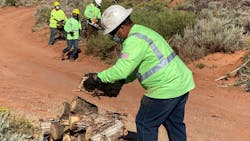Vegetation Management Benefits Navajo
On July 7, Desert Southwest (DSW) vegetation management crews set to work on an interim Integrated Vegetation Management (IVM) project along the Navajo-to-Long House Valley 230-kV transmission line in Arizona. The work focused on vegetation within the line's right of way.
According to the Environmental Protection Agency (EPA), IVM is generally defined as "the practice of promoting desirable, stable, low-growing plant communities — that will resist invasion by tall growing tree species — through the use of appropriate, environmentally sound, and cost-effective control methods. These methods can include a combination of chemical, biological, cultural, mechanical, and/or manual treatments."
The EPA goes on to specify that poorly managed vegetation and overgrowth, on rights of way in particular, can result in service disruption, worker endangerment, forest fires, erosion, and pollution.
The work DSW performed in July involved hand cutting incompatible vegetation and trimming trees as necessary to minimize vegetative threats to the safety, security, and reliability of the transmission system.
"The prescription called for the removal and chipping of incompatible vegetation in the wire zone or essentially the area directly below the circuit," said WAPA Vegetation Program Manager Steve Narolski. "We targeted vegetation that threatened clearance to Western Area Power Administration (WAPA) conductors or presented a fuel ladder, where flame lengths, heat, or smoke could impact reliability in the case of a wildfire."
The work followed a July 6 environmental awareness training hosted by Supervisory Environmental Protection Specialist Sean Berry.
COVID-19 struck the Navajo Nation as DSW's Environment team was working with them to identify cultural sites, as well as any potential endangered species or nesting concerns.
Coordinating with the Navajo Nation is crucial when performing work such as this, which resulted in the initiative being split into multiple phases. With the Navajo government shut down, a special agreement with their president was necessary for this interim treatment to proceed.
"Once Environment has completed the required communications with the Navajo Nation government, the original project's prescription of mowing the 24-miles west of the Longhouse Valley substation, excluding 'no mechanical entry' where needed to protect cultural sites, will be executed," said Narolski. "We will await the Navajo Nation's concurrence and the remainder of the IVM work will most likely take place next year."
In addition to the above considerations, WAPA agreed to salvage and stack usable firewood chunks out of any felled juniper, pinyon pine, and ponderosa pine where feasible. Firewood is a very useful and welcome commodity in the Navajo Nation.
"The plan was to stack up the salvaged firewood and send a list of their locations to the Navajo Nation, and then the tribal elders would come out later and collect the wood," said Narolski. "In reality, the elders had already learned about this and were actively collecting the firewood as quickly as our contractor cut it!"
In a few areas along the right of way, access restrictions prevented the crew from bringing the chipper with them while they worked. In these areas, the felled trees were chopped up and scattered.
Narolski returned to the area to inspect the work the following week.
"I want to thank Sean and the Environment staff for working to enable the interim treatment, giving WAPA and its customers some peace of mind toward fireproofing this specific circuit," he said. "Their efforts have enabled us to help maintain WAPA's core mission under the extraordinary weather and wildfire danger that all of DSW has seen this season. Without their efforts to enable IVM projects to occur, DSW would have surely lost multiple circuits this year to wildfires."
— Philip Reed
